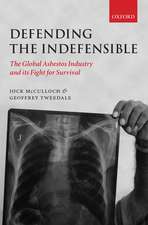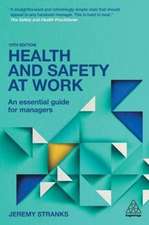Integrated Occupational Safety and Health Management: Solutions and Industrial Cases
Editat de Seppo Väyrynen, Kari Häkkinen, Toivo Niskanenen Limba Engleză Hardback – 19 ian 2015
Exploring the complexity of leadership by the impact that contexts (e.g., national and organizational culture) may have on leaders, this book discusses the related literature, then moves forward to show how a more comprehensive practical approach to Occupational Safety and Health and performance excellence can function on levels pertaining to events, individuals, groups, and organizations. This book proposes that greater clarity in understanding leadership in Occupational Safety and Health and performance excellence can be developed from addressing two fundamental issues. Firstly, how do subunit inputs and processes combine to produce unit-level outcomes and how does leadership affect this process? Secondly, how do the leaders influence the way that individual-level inputs are combined to produce organizational outputs. In these issues, the alternative methodologies that allow precise measurement of organizational outputs in OSH and performance excellence are reviewed.
To help readers navigate through the best practices, each chapter contains Question Guidelines, Exercises and Case studies which illustrate the concepts discussed and which serves to highlight the key evidence demonstrating that collaborative leadership can positively affect individual, group, and organizational level outcomes, including organizational OSH and performance excellence.
| Toate formatele și edițiile | Preț | Express |
|---|---|---|
| Paperback (1) | 641.53 lei 6-8 săpt. | |
| Springer International Publishing – 24 sep 2016 | 641.53 lei 6-8 săpt. | |
| Hardback (1) | 647.92 lei 6-8 săpt. | |
| Springer International Publishing – 19 ian 2015 | 647.92 lei 6-8 săpt. |
Preț: 647.92 lei
Preț vechi: 762.26 lei
-15% Nou
Puncte Express: 972
Preț estimativ în valută:
123.98€ • 132.58$ • 103.37£
123.98€ • 132.58$ • 103.37£
Carte tipărită la comandă
Livrare economică 17 aprilie-01 mai
Preluare comenzi: 021 569.72.76
Specificații
ISBN-13: 9783319131795
ISBN-10: 3319131796
Pagini: 306
Ilustrații: XI, 306 p. 56 illus.
Dimensiuni: 155 x 235 x 25 mm
Greutate: 0.63 kg
Ediția:2015
Editura: Springer International Publishing
Colecția Springer
Locul publicării:Cham, Switzerland
ISBN-10: 3319131796
Pagini: 306
Ilustrații: XI, 306 p. 56 illus.
Dimensiuni: 155 x 235 x 25 mm
Greutate: 0.63 kg
Ediția:2015
Editura: Springer International Publishing
Colecția Springer
Locul publicării:Cham, Switzerland
Public țintă
ResearchCuprins
General Introduction.- Preventing OSH losses by developing safety culture and leadership.- Views on OSHM and cases towards continuous improvements.- Effects of the OSHM.- Questions on issues and good practices arisen.- Assignments and exercises supporting applying the approaches.
Notă biografică
Seppo Väyrynen
Seppo Väyrynen has been a Professor of Work Science at the University of Oulu, Oulu, Finland since 1989. His other main employers comprise the Finnish Institute of Occupational Health, for 12 years, and the Academy of Finland.
He achieved Master's (1974) and Doctor's (1986) degrees in Engineering science, the theses for which dealt with the work environment and ergonomics development being linked to mechanical engineering design and management.
In addition to heading a unit at the Department of Industrial Engineering and Management, he has taught various courses in ergonomics and safety engineering, supervising doctoral students, and has directed a research group with many R&D projects.
His research interests include ergonomics, human actors, well-being and productivity within work system, user-centred design, usability engineering, participative development and innovation, safety-conscious design, risk control, accidents and occupational risk prevention, safety management and integrated management systems (Health, Safety, Environment, Quality).
He has published more than 370 scientific or professional articles and book chapters.
Kari Häkkinen
Dr. Kari K. Häkkinen is currently head of health and safety RM, at If P&C Insurance Company Ltd, Espoo.
Holding an M.Sc.in Engineering, from the Dept of Mining and Metallurgy, Helsinki University of Technology (1976),and a Licentiate of Technology from the Safety Technology Dept, Tampere University of Technology (1982), he obtained a Dr. of Technology degree from Helsinki University of Technology in 1985.
Dr Häkkinen has over 30 years of expertise in health and safety consulting, risk management, safety research and development for industry in Finland and internationally.
He has consulted and training on a variety of Health and safety issues for a wide range of industries, including manufacturing, construction, plantmaintenance and services as well as having several years of experience as a department manager and team leader in risk management and EHS.
Toivo Niskanen
Dr Toivo Niskanen currently works as a Senior Officer in the Finnish Ministry of Social Affairs and Health, Department for Occupational Safety and Health, Legislation Unit.
He received a Master of Science in Construction Engineering degree in 1975 from the University of Oulu and a Doctor of Technology in 1993 from the Technical University of Helsinki (today Aalto University). He has worked as the safety inspector at the Finnish Board of Labour Protection (in 1975-1977) and as the senior researcher in the Finnish Institute of Occupational Health (in 1978-1990). From 1990 to the present, he has worked as the senior adviser in the Legislation Unit of the Department for Occupational Safety and Health in the Ministry of Social Affairs and Health preparing some of the implementations of the EU directivesin Finnish legislation e.g. the Council Directive 92/57/EEC of 24 June 1992 on the implementation of minimum safety and health requirements at temporary or mobile construction sites. With respect to the other EU directives he have participated in three working groups making amendment to the existing Council Directives.
Seppo Väyrynen has been a Professor of Work Science at the University of Oulu, Oulu, Finland since 1989. His other main employers comprise the Finnish Institute of Occupational Health, for 12 years, and the Academy of Finland.
He achieved Master's (1974) and Doctor's (1986) degrees in Engineering science, the theses for which dealt with the work environment and ergonomics development being linked to mechanical engineering design and management.
In addition to heading a unit at the Department of Industrial Engineering and Management, he has taught various courses in ergonomics and safety engineering, supervising doctoral students, and has directed a research group with many R&D projects.
His research interests include ergonomics, human actors, well-being and productivity within work system, user-centred design, usability engineering, participative development and innovation, safety-conscious design, risk control, accidents and occupational risk prevention, safety management and integrated management systems (Health, Safety, Environment, Quality).
He has published more than 370 scientific or professional articles and book chapters.
Kari Häkkinen
Dr. Kari K. Häkkinen is currently head of health and safety RM, at If P&C Insurance Company Ltd, Espoo.
Holding an M.Sc.in Engineering, from the Dept of Mining and Metallurgy, Helsinki University of Technology (1976),and a Licentiate of Technology from the Safety Technology Dept, Tampere University of Technology (1982), he obtained a Dr. of Technology degree from Helsinki University of Technology in 1985.
Dr Häkkinen has over 30 years of expertise in health and safety consulting, risk management, safety research and development for industry in Finland and internationally.
He has consulted and training on a variety of Health and safety issues for a wide range of industries, including manufacturing, construction, plantmaintenance and services as well as having several years of experience as a department manager and team leader in risk management and EHS.
Toivo Niskanen
Dr Toivo Niskanen currently works as a Senior Officer in the Finnish Ministry of Social Affairs and Health, Department for Occupational Safety and Health, Legislation Unit.
He received a Master of Science in Construction Engineering degree in 1975 from the University of Oulu and a Doctor of Technology in 1993 from the Technical University of Helsinki (today Aalto University). He has worked as the safety inspector at the Finnish Board of Labour Protection (in 1975-1977) and as the senior researcher in the Finnish Institute of Occupational Health (in 1978-1990). From 1990 to the present, he has worked as the senior adviser in the Legislation Unit of the Department for Occupational Safety and Health in the Ministry of Social Affairs and Health preparing some of the implementations of the EU directivesin Finnish legislation e.g. the Council Directive 92/57/EEC of 24 June 1992 on the implementation of minimum safety and health requirements at temporary or mobile construction sites. With respect to the other EU directives he have participated in three working groups making amendment to the existing Council Directives.
Textul de pe ultima copertă
Maximizing reader insights into a new movement toward leadership approaches that are collaborated and shared, and which views Occupational Safety and Health (OSH) and performance excellence within the wider examination of leadership relationships and practices, this book argues that these relationships and processes are so central to the establishment of OSH functioning that studying them warrants a broad, cross-disciplinary, multiple method analysis.
Exploring the complexity of leadership by the impact that contexts (e.g., national and organizational culture) may have on leaders, this book discusses the related literature, then moves forward to show how a more comprehensive practical approach to Occupational Safety and Health and performance excellence can function on levels pertaining to events, individuals, groups, and organizations. This book proposes that greater clarity in understanding leadership in Occupational Safety and Health and performance excellence can be developed from addressing two fundamental issues. Firstly, how do subunit inputs and processes combine to produce unit-level outcomes and how does leadership affect this process? Secondly, how do the leaders influence the way that individual-level inputs are combined to produce organizational outputs. In these issues, the alternative methodologies that allow precise measurement of organizational outputs in OSH and performance excellence are reviewed.
To help readers navigate through the best practices, each chapter contains Question Guidelines, Exercises and Case studies which illustrate the concepts discussed and which serves to highlight the key evidence demonstrating that collaborative leadership can positively affect individual, group, and organizational level outcomes, including organizational OSH and performance excellence.
Exploring the complexity of leadership by the impact that contexts (e.g., national and organizational culture) may have on leaders, this book discusses the related literature, then moves forward to show how a more comprehensive practical approach to Occupational Safety and Health and performance excellence can function on levels pertaining to events, individuals, groups, and organizations. This book proposes that greater clarity in understanding leadership in Occupational Safety and Health and performance excellence can be developed from addressing two fundamental issues. Firstly, how do subunit inputs and processes combine to produce unit-level outcomes and how does leadership affect this process? Secondly, how do the leaders influence the way that individual-level inputs are combined to produce organizational outputs. In these issues, the alternative methodologies that allow precise measurement of organizational outputs in OSH and performance excellence are reviewed.
To help readers navigate through the best practices, each chapter contains Question Guidelines, Exercises and Case studies which illustrate the concepts discussed and which serves to highlight the key evidence demonstrating that collaborative leadership can positively affect individual, group, and organizational level outcomes, including organizational OSH and performance excellence.
Caracteristici
Provides a cross-disciplinary analysis of Occupational Safety and Health in the context of leadership relationships and practices Broadens the understanding of Occupational Safety and Health both as a specific process and as embedded in work system and processes Includes case studies which serve to demonstrate how collaborative leadership can positively affect individual, group, and organizational level outcomes Includes supplementary material: sn.pub/extras
















